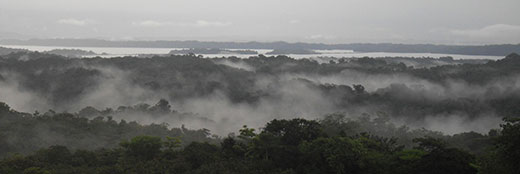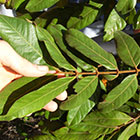Tropical forest growth depends on nitrogen fixing trees
Young growing tropical forests produce their own fertiliser. A new study published in the journal Nature shows that the recovery of tropical forests critically depends on the presence of tree species from the legume family (the pea family) capable of turning atmospheric nitrogen into fertiliser by a process called nitrogen fixation.

These tropical forests in the Panama canal zone can regrow rapidly after previous land use due to the presence of nitrogen fixing tree species
A team of researchers studied tropical forest growth by comparing forest biomass across forest patches of different ages in the Agua Salud Project area of the Smithsonian Tropical Research Institute (STRI) in Panama. They also measured how much nitrogen, an essential nutrient for plant growth, was provided by nitrogen fixing trees. “It takes only 12 years to accumulate 50 000 kg of carbon per hectare. This is 40% of the carbon present in mature forests” says co-author Johannes Ransijn, a PhD-student at the Department of Geosciences and Natural Resource Management at the University of Copenhagen. “This rapid forest growth was only possible because of the nitrogen fixing species; they supplied over 50% of the nitrogen needed”

Inga thibaudiana, one of the nitrogen fixing tree species
Only a minority of the trees fix nitrogen, but as nitrogen cycles through the ecosystem, other neighbouring trees can benefit from the extra nitrogen as well. “The proportion of trees that are actually fixing nitrogen is highest in young forest and nitrogen fixing individuals have a strong competitive advantage in young forests” says Johannes Ransijn. “They grow up to nine times faster than non-fixing trees in 5 year old forests”. This advantage decreases when the forest matures and becomes more nitrogen rich, but the nitrogen fixing species differ in their characteristics. "Each tree species fixes nitrogen and carbon differently, so species important at 12 years drop out or become less common at 30 years" says first author Sarah Batterman, a postdoctoral researcher at Princeton University. "If you were to lose a species and it turned out to be essential for a specific time period, fixation might drop dramatically" says Sarah Batterman. “Diversity really matters”.
The nitrogen fixing ability is critical for the growth of young forests. How forests grow back after exploitation is especially relevant because a large and increasing proportion of global forests is growing on previously deforested land and the new findings are important for the understanding of forests interactions with global climatic change and rising CO2 concentrations.

Johannes Ransjin, IGN, University of Copenhagen
Johannes Ransijn collaborated in this study with lead author Sarah Batterman and Lars Hedin from Princeton University, Michiel van Breugel and Jefferson Hall from STRI and Dylan Craven from Yale University.
Reference:
Batterman, S.A., Hedin, L.O., van Breugel, M., Ransijn, J., Craven, D.J., Hall, J.S. 2013. Key role of symbiotic N2 fixation in tropical forest secondary succession. Nature (online – 15 September 2013). doi:10.1038/nature12525
Contact
Johannes Ransijn
PhD Student
jran@life.ku.dk
35336538
